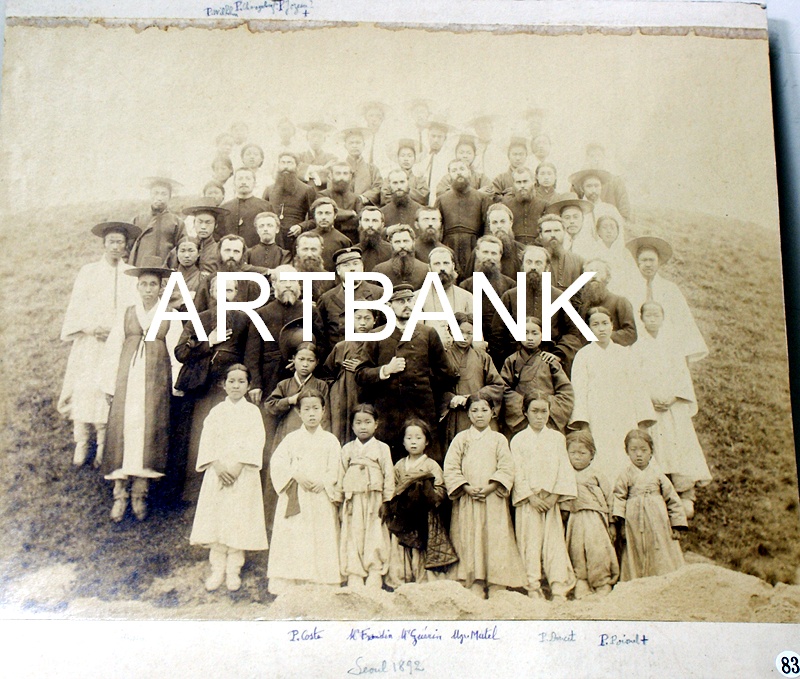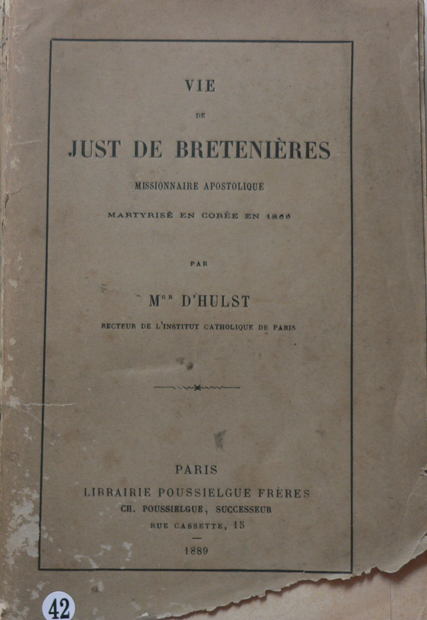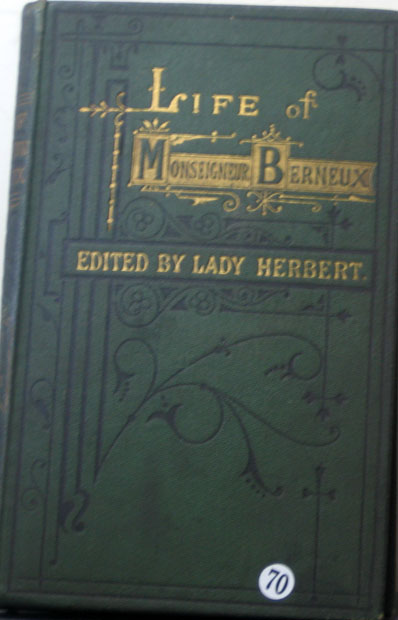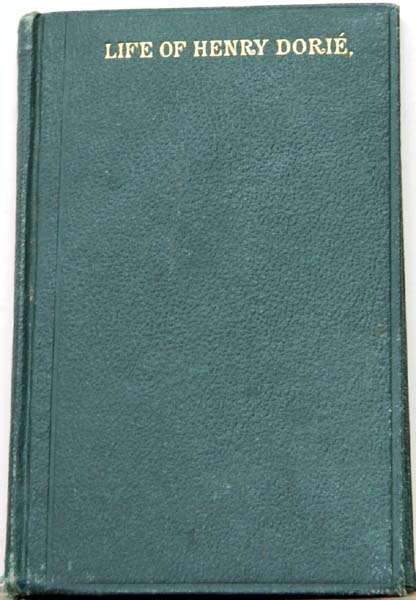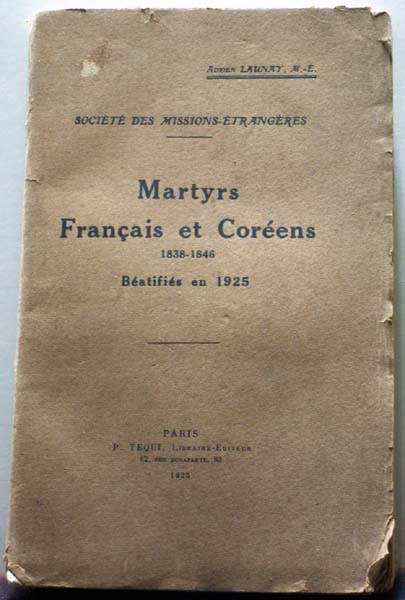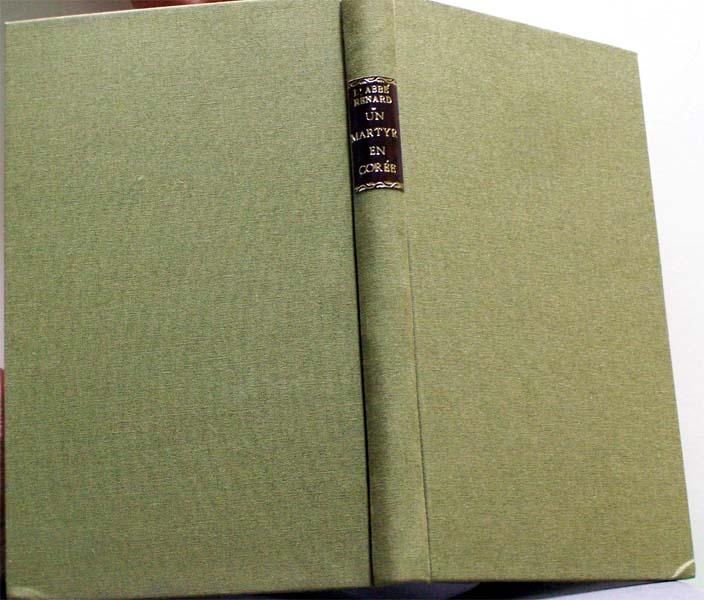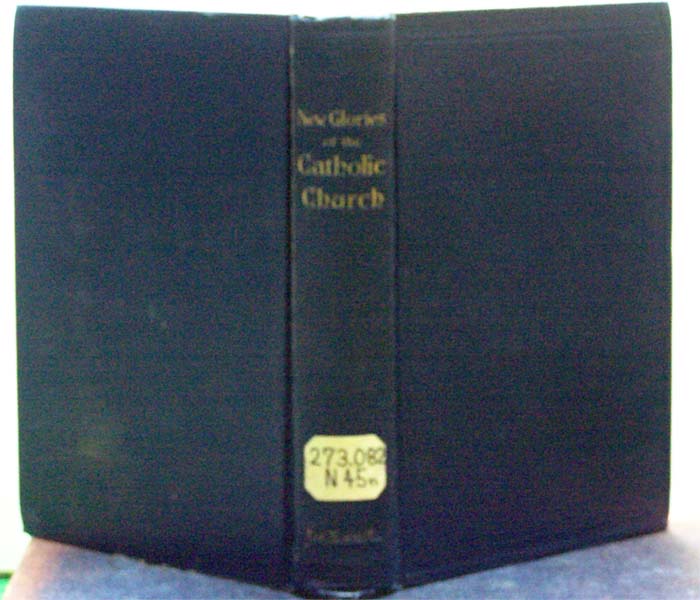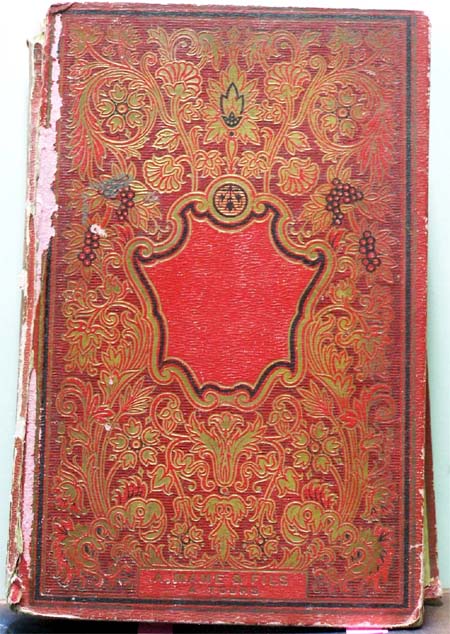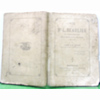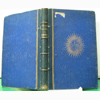| 759 |
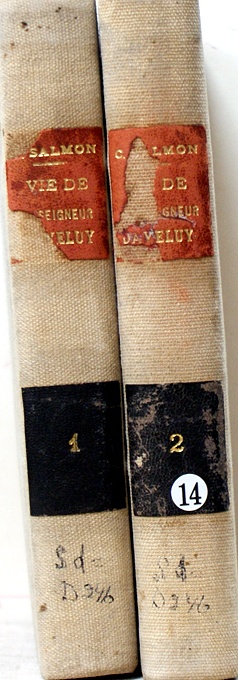
| |
Vie Monseigneur Daveluy
/1883
hard cover in 2 volumes. Volume one: 323 pages. Volume 2 : 325 pages.Exytremely Rare
sources on the martyrdom of French missions headed by Korean authority
in 1866 in Korea.
|
Charles Salmon |
Bray et Retaux,Paris |
French
|
|
|
|
|
|
|
|
| 713 |
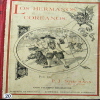
| |
LOS HERMANOS COREANOS /1898
hard cover.Octavo.107 pages. first edition in Spainish. Rare souce on the catholicism in Korea.
|
P.Jose Spillman |
Friburgo de Brisgovia(Alemania )B.Herder,Libero-Editor Pontificio |
Others
|
|
|
|
|
| 656 |
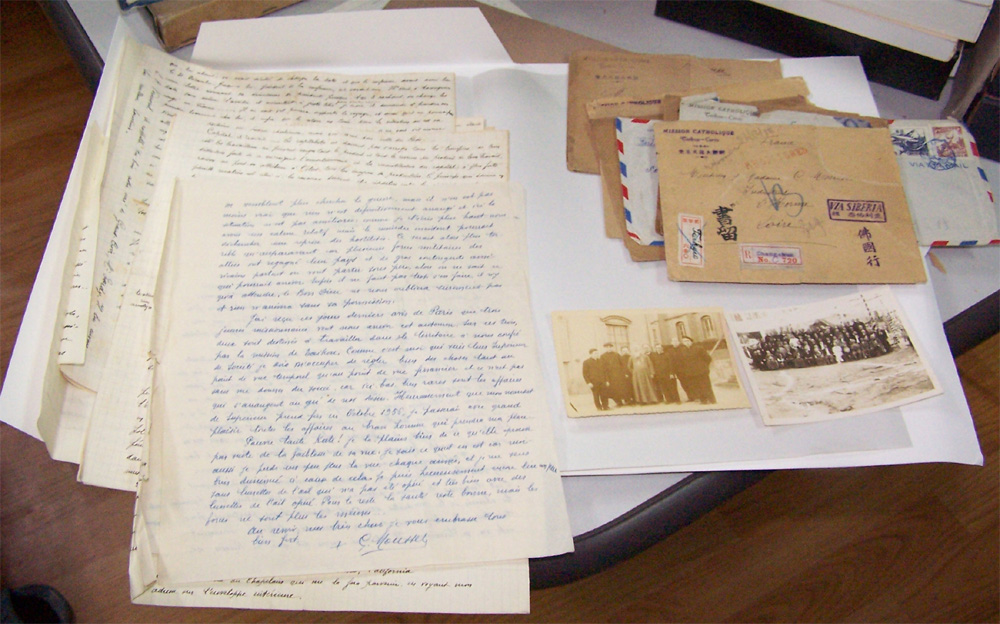
| |
18 letters and 2 photographs of French
Catholic Mission (Mousset Germain 1876 -1957) in Korea.
/1917
Museum Quality catholic materials of Mousset Germain (1876 1957: who lived in Korea from 1917 to 1955 ?)
1) 3 letters from France before he left for Korea in 1917.(October 14,1917/October 30,1917November 26,1917)
2) December 14,1917 from Taikou(Daeku),Korea
3) July 14,1919 from Daeku,Korea
4)December 8,1923 fro Daeku,Korea
5)January 11,1924 from Daeku,Korea
6)December 8,1927 from Daeku,Korea
7)December 2,1928 from Daeku,Korea
8)May 11,1932 from Daeku,Korea
9)May 16,1932 from Daeku,Korea
10)October,29 1935 from Saigon,Vietnam
11)November 22,1935 from Daeku,Korea
12)September 13,1936 from Daeku,Korea
13)November 10,1936 from Daeku,Korea
14)January 24,1946 from Daeku,Korea
15)May 23,1955 from Seoul,Korea
16) July 11,1955 from Seoul,Korea ---------------------------------------
17) 2 original photographs(size: 10.5x8cmand 10x17cm )
18) 13 used letter envelopes( 9 envelopes stamped Mission catholique Taikou-Coree(ðÈàØÓÞÏÈô¸ñ«ÓÑ ,one envelope handwritten by Mousset Germain from Seoul,Korea. 3 used envelopes without postal address)
|
Mousset Germain (1876 -1957) |
. |
French
|
|
|
|
| 645 |

| |
Just de Bretenieres /1910
hard cover, 8 vo.372 pages. First edition. Catholic material focused on the
life and martyrdom of Mgr.Just de Bretenieres beheaded by the Korean authority on March 8,1866 in Korea.
|
C. Appert |
Librairie Emmanuel Vitte,Paris/Lion |
French
|
|
|
|
|
|
| 528 |
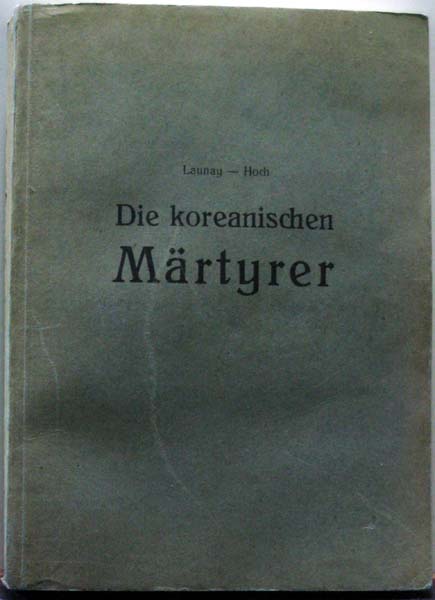
| |
Die Koreanischen MARTYRER 1838-1846/1929
paperback, 8 vo. 270 pages. First edition.Illustrated with 16 black and white
photographs and 1 folded map.Rare work about persecution of Christians in Korea in the middle of the 19th century.
|
Adrien Launay |
Missionsverlag St.Ottilien,Germany |
German
|
|
|
|
|
| 502 |
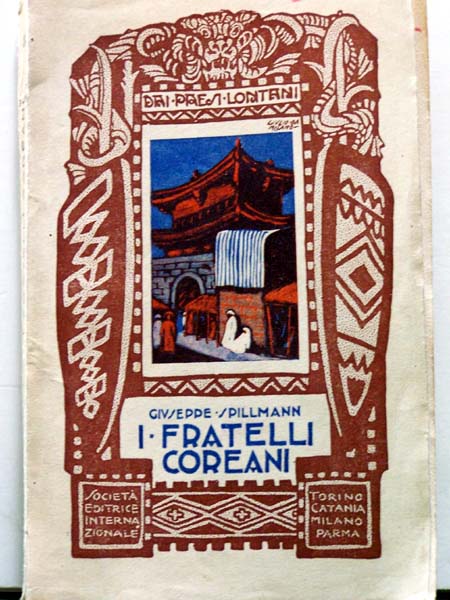
| |
I Fratelli Coreani/1910
paperback, 12 mo.107 pages.ca.1910
Story of Korean Borthers being Christian at the beginning of the 20th Century.
|
Giuseppe Spillmann |
Societa Editrice International ,Torino,Italy |
Italian
|
|
|
| 493 |
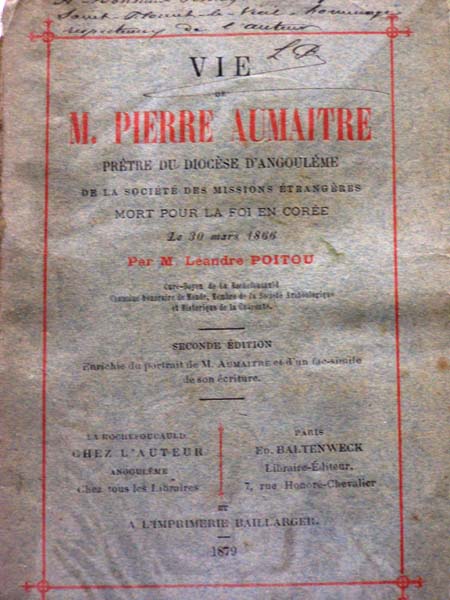
| |
VIE DE M.PIERRE AUMAITRE/1879
Paperback, 8vo.345 pages .frist edition.
General overview of the Catholic church in Korea and M.P.Aumaitre beheaded
by Korean authority in 1866. Very rare source on the history of Catholic church in Korea in 19th century.
|
M.Leandre Potou |
A L'Impreimerie Baillarger |
French
|
|
|
|
| 486 |
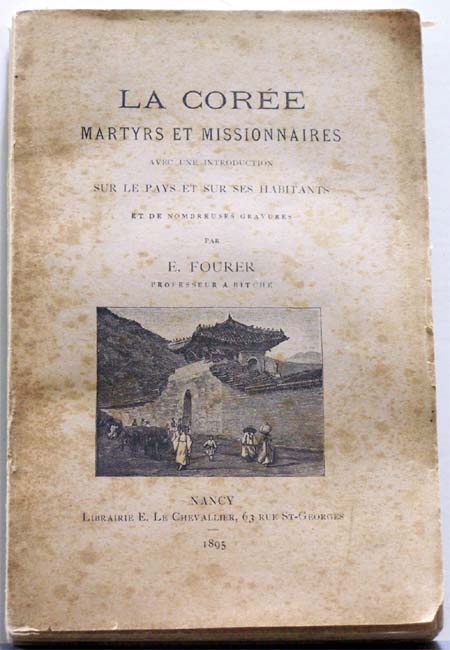
| |
LA COREE Martyrs et Missionnaires/1895
soft cover,8 vo. first edition.316 pages. Numerous illustrations.
General overview of the political situation of Korea and catholic church and catholic peoples beheaded in Korea in 19th century.Rare source on catholic
church in old Korea.
|
E.Flourer |
Librairie E.Le Chevallier ,Nancy,France |
French
|
|
|
|
|
|
| 483 |
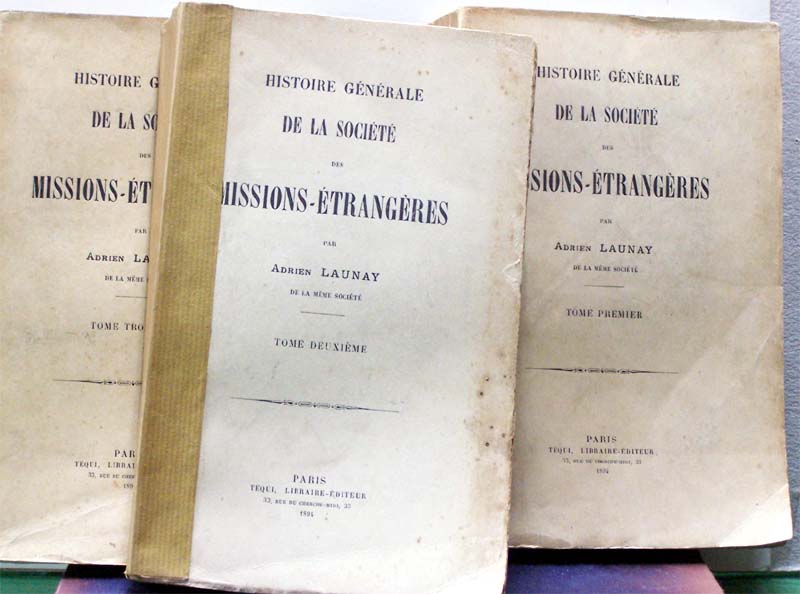
| |
Histoire Generale de la Societe des MISSIONS-ETRANGERES(General History of the Society of Foreign Missions of Paris)/1894
Softcover in 3 volumes.8 vo. Paperbound. 595, 594, 646 pages. First edition.
Many references to history of Catholic church in Korea.................................
The Society of Foreign Missions of Paris was established in 1658-63, its chief founders being Mgr Pallu, Bishop of Heliopolis, Vicar Apostolic of Tongking, and Mgr Lambert de la Motte, Bishop of Bertyus, Vicar Apostolic of Conchin-China. Both bishops left France (1660-62) to go to their respective missions and as true travellers of Christ they crossed Persia and India on foot. The object of the new society was and is still the evangelization of infidel countries, by founding churches and raising up a native clergy under the jurisdiction of the bishops. In order that the society might recruit members and administer its property, a house was established in 1663 by the priests whom the vicars Apostolic had appointed their agents. This house, whose directors were to form young priests to the apostolic life and transmit to the bishops the offerings made by charity, was, and is still situated in Paris in the Rue de Bac. Known from the beginning as the seminary of Foreign Missions, its secured the approval of Alexander VII, and the legal recognition, still in force, of the French Government.
The nature and organization of the society deserves special mention. It is not a religious order but a congregation, a society of secular priests, united as members of the same body, not by vows but by the rule approved by the Holy See, by community of object, and the seminary of Foreign Missions, which is the centre of the society and the common basis which sustains the other parts. On entering the society the missionaries promise to devote themselves until death to the service of the missions, while the society assures them in return, besides the means of sanctification and perseverance, all necessary temporal support and assistance. There is no superior general; the bishops, vicars Apostolic, superiors of missions and board of directors of the seminary are the superiors of the society. The directors of the seminary are chosen from among the missionaries and each group of missions is represented by a director. The bishops and vicars Apostolic are appointed by the pope, after nomination by the missionaries, and presentation by the directors of the seminary. In their missions they depend only on Propaganda and through it on the pope. No subject aged more than thirty-five may be admitted to the seminary nor may anyone become a member of the society before having spent three years in the mission field. Several points of this rule were determined from the earliest year of the society's existence, and others were established by degrees and as experience pointed out their usefulness. By this rule the society has lived and according to it its history has been outlined.
This history is difficult, for owing to the length of the journeys, the infrequent communication, and the poverty of resources the missions have developed with difficulty. The chief events of the first period (1658-1700) are: the publication of the book "Institutions apostoliques", which contains the germ of the principles of the rule, the foundation of the general seminary at Juthia, (Siam), the evangelization of Tongking, Cochin China, Cambodia, and Siam, where more than 40,000 Christians were baptized, the creation of an institute of Annamite nuns known as "Lovers of the Cross", the establishment of rules among catechists, the ordination of thirty native priests. Besides these events of purely religious interest there were others in the political order which emphasized the patriotism of these evangelical labourers: through their initiative a more active trade was established between Indo-China, the Indies, and France; embassies were sent from place to place; treaties were signed; a French expedition to Siam took possession of Bangkok, Mergin, and Jonselang, and France was on the verge of possessing an Indo-Chinese empire when the blundering of subalterns ruined an undertaking the failure of which had an unfortunate influence on the missions. But the most important work of the vicars Apostolic and the society is the application of the fruitful principle of the organization of churches by native priests and bishops. Thenceforth the apostolate in its progress has has followed this plan in every part of the world with scrupulous fidelity and increasing success. In the second half of the eighteenth century it was charged with the missions which the Jesuits had possessed in India prior to their suppression in Portugal. Many of the Jesuits remained there. The missions thereupon assumed new life, especially at Setchoan, where remarkable bishops, Mgr Pottier and Mgr Dufresse, gave a strong impulse to evangelical work; and in Cochin China, where Mgr Pineau de Behaine performed signal service for the king of that country as his agent in making with France a treaty, which was the first step towards the splendid situation of France in Indo-China. At the end of the eighteenth century the French revolution halted the growth of the society, which had previously been very rapid. At that time it had six bishops, a score of missionaries, assisted by 135 native priests; in the various missions there were nine seminaries with 250 students, and 300,000 Christians. Each year the number of baptisms rose on a average of 3000 to 3500; that of infant baptisms in articulo mortis was more than 100,000.
In the nineteenth century the development of the society and its missions was rapid and considerable. Several causes contributed to this; chiefly the charity of the Propagation of the Faith and the Society of the Holy Childhood; each bishop receives annually 1200 francs, each mission has its general needs and works allowance, which varies according to its importance, and may amount to from 10,000 to 30,000 francs. The second cause was persecution. Fifteen missionaries died in prison or were beheaded during the seventeenth and eighteenth centuries and the beginning of the nineteenth century; but after that the martyrs among the missionaries were very numerous. The best known are Mgr Dufresse, vicar Apostolic of Se-tchoan, beheaded in 1815; Gagelin, Marchand, Jaccard, Cornay, and Dumoulin-Borie from 1833 to 1838; and from 1850 to 1862 Schoeffler, Vénard, Bonnard, Néron, Chapdelaine, Néel, Cuenot, vicar Apostolic of Eastern Cochin China. If, besides these, mention were made of the native priests, catechists, and nuns, in short of all who died for Christ, we should have a record of one of the bloodiest holocausts in history. These persecutions were described in Europe by books, pamphlets, annals, and journals, arousing the pity of some and the anger of others, and inspiring numerous young men either with the desire or martyrdom or that of evangelization. They moved European nations, especially France and England, to intervene in Indo-China and China, and open up in these countries an era of liberty and protection till then unknown. Another cause of the progress of the missionaries was the ease and frequency of communication in consequence of the invention of steam and the opening of the Suez Canal. A voyage could be made safely in one month which formerly required eight to ten months amid many dangers.
The following statistics of the missions confided to the Society will show this development at a glance: Missions of Japan and Korea — Tokio, Nagasaki, Osaka, Hakodate, Korea, total number of Catholics, 138,624; churches or chapels, 238; bishops and missionaries, 166; native priests, 48; catechists, 517; seminaries, 4; seminarists, 81; communities of men and women, 44, containing 390 persons; schools, 161, with 9024 pupils; orphanages and work-rooms, 38, with 988 children; pharmacies, dispensaries, and hospitals, 19. Missions of China and Tibet — Western, Eastern, and Southern Se-tchoan, Yun-nan, Kouy-tcheou, Kouang-ton, Kouang-si, Southern Manchuria, Northern Manchuria. — Catholics, 272,792; churches or chapels, 1392; bishops and missionaries, 408; native priests, 191; catechists, 998; seminaries, 19; seminarists, 661; communities of men and women, 23, with 222 members; schools, 1879, with 31,971 pupils; orphanages and work-rooms, 132, with 4134 children; pharmacies, dispensaries, and hospitals, 364. Missions of Eastern Indo-China — Tongking, Cochin China, Cambodia — Catholic population, 632,830; churches or chapels, 2609; bishops and missionaries, 365; native priests, 491; catechists, 1153; seminaries, 14; seminarists, 1271; communities of men and women, 91, with 2538 persons; schools, 1859, with 58,434 pupils; orphanages and work-rooms, 106, with 7217 children; pharmacies, dispensaries, and hospitals, 107. Missions of Western Indo-China — Siam, Malacca, Laos, Southern Burma, Northern Burma — Catholics, 132,226; churches or chapels, 451; bishops and missionaries, 199; native priests, 42; catechists, 242; seminaries, 3; seminarists, 81; communities of men and women, 47, with 529 members; schools, 320, with 21,306 pupils; orphanages and work-rooms, 132, with 3757 children; pharmacies, dispensaries, and hospitals, 86. Missions of India — Pondicherry, Mysore, Coimbatore, Kumbakonam. — Catholics, 324,050; churches or chapels, 1048; bishops and missionaries, 207; native priests, 67; catechists, 274; seminaries, 4; seminarists, 80; communities of men and women, 54, with 787 members; schools, 315, with 18,693 pupils; orphanages and work-rooms, 57, with 2046 children; pharmacies, dispensaries, and hospitals, 41.
In addition to these missionaries actively engaged in mission work, there are some occupied in the establishments called common, because they are used by the whole society. Indeed the development of the society necessitated undertakings which were not needed in the past. Hence a sanatorium for sick missionaries has been established at Hong-Kong on the coast of China; another in India among the Nilgiri mountains, of radiant appearance and invigorating climate, and a third in France. In thinking of the welfare of the body, that of the soul was not lost sight of, and a house of spiritual retreat was founded at Hong-Kong, wither all the priests of the society may repair to renew their priestly and apostolic fervour. To this house was added a printing establishment whence issue the most beautiful works of the Far East, dictionaries, grammars, books of theology, piety, Christian doctrine, and pedagogy. Houses of correspondence, or agencies, were established in the Far East, at Shanghai, Hong-Kong, Saigon, Singapore, and one at Marseilles, France. The Seminary of the Foreign Missions which long had only one section, has for twenty years had two.
|
Adrien Launay |
Tequi,Libaire-Editeur .Paris |
French
|
|
|
| 481 |

| |
The Corean Martyrs/1870
hard cover, 12mo ,115 pages. ca.1870.
General overview of the catholic peoples beheaded by
Korean Government in 1866 in Korea.Extremely rare source on catholic
church in Korea.
|
Canon Schortland |
Burns,Oates & Co.,London |
English
|
|
|
| 423 |
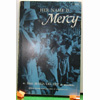
| |
Her Name is MERCY/1957
paperback, 8vo.184 pages. first edition.
Illustrated with b/w Photos. Sister Maria Del Rey of the Maryknoll Sisters tells the dramatic & exciting story of Sister Mary Mercy and her medical work under frightful post-war conditions in Korea in 1951.The dramatic and exciting story of Sister Mary Mercy and her medical work under fightful post-war conditions in Korea. A doctor, she found a real vocation too as a Maryknoll Sister. Tells how three Maryknoll Sisters, working with the barest essentials and often without them, became the core of a hard-working, tremendously successful team of workers from every walk of life and from many different countries. The clinic which they started in 1951 treated 100 patients a morning, but by 1954 was treating about 2600 a day. Originally housed by makeshift methods - old cartons, tin cans flattened for the roof - the book ends with the construction of a new 160-bed hospital - the largest in Korea.
|
Sister Maria Del Rey of Maryknoll |
Charles Scribner's Sons ,New York |
English
|
|
|
|
|
|
| 406 |
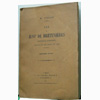
| |
Vie de Just de Breteniers Missionarire Apostolique martyrise en COREE en 1866/1926
paperback,8 vo. 347 pages.
A classic of Catholic missionary stories. A superb biography of the life of Just de Bretenieres from birth in France in 1829, early childhood, boyhood and entrance to the seminary at Issy, the foreign mission seminary, his ordination. The very long voyage to Asia, via Ceylon, Malacca, Singapore, Saigon, Hong Kong, Canton, Manchuria and finally Korea. He spent the first winter in Manchuria and began the study of Korean. In 1865 his work begain in Korea as a missioner, worked with Father Paik Chen Fou. Comlaints about the horrible pirates and murderers, many were beheaded by the authorities. Revolution was sweeping across Korea, the persecution and martyrdom of Christian was common and his friend, Father Paik was among the first to be tortured and beheaded. All foreign missioners Bishop Berneux, Father de Bretenieres, Father Beaulieu and Father Dorie were put to death that day in 1881. Each placed in a charir, arms & legs tied, hair pulled back by strings to the chair.Before each man's head hung a plackard REBELLIOUS, DISOBEDIENT, CONDEMNED TO DIE AFTER BEING TORTURED. The curious crowds gathered to see the priests put to death in the Seoul arena. A fascinating story, well written. Also covers his work in Taikou with choir boys. In Quelpaert his work with Corean children, and as Bishop of Seoul. He contributed some 21 years of his life to improving the life of Koreans.
|
M.D'Hulst |
J.De Giford,Editeurs,Paris |
French
|
|
|
|
[1]2 |


